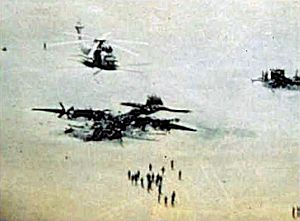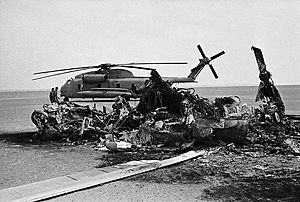Operation Eagle Claw facts for kids
Quick facts for kids Operation Eagle Claw |
|
|---|---|
| Part of the Iran Hostage Crisis | |

Overview of the wreckage at the Desert One base in Iran
|
|
| Location | Near Tabas, South Khorasan, Iran 33°04′23″N 55°53′33″E / 33.07306°N 55.89250°E |
| Commanded by |
|
| Target | Embassy of the United States, Tehran |
| Date | 24–25 April 1980 |
| Executed by |
Logistical support: |
| Outcome | Mission failed 1 helicopter and 1 transport aircraft destroyed 5 helicopters abandoned/captured |
| Casualties | 8 US servicemen killed & 4 injured 1 Iranian civilian killed |
Operation Eagle Claw, also known as Operation Tabas in Iran, was a secret mission by the U.S. military. It was ordered by U.S. President Jimmy Carter on April 24, 1980. The goal was to rescue 52 American embassy workers who were being held hostage in Tehran, Iran.
This operation was one of the first big missions for Delta Force, a special military unit. It faced many problems and failed. Eight helicopters were sent to a secret meeting spot called Desert One, but only five arrived ready to fly. One helicopter had engine trouble, another got caught in a huge sandstorm, and a third had a cracked rotor blade. The plan said the mission should be stopped if fewer than six helicopters were working. Even though only four were absolutely needed, the commanders decided to call off the mission. President Carter agreed.
As the U.S. forces were getting ready to leave Desert One, one of the remaining helicopters crashed into a transport plane. This plane was carrying soldiers and jet fuel. The crash caused a big fire that destroyed both aircraft. Eight American soldiers died in the accident.
After the mission failed, Iran's leader, Ayatollah Ruhollah Khomeini, said that God had stopped the U.S. mission to protect Iran. President Carter later said that the failure to free the hostages was a main reason he lost the 1980 U.S. presidential election. The American hostages were finally released shortly after Ronald Reagan became president.
Contents
What Happened After the Mission?
The White House announced the failed rescue mission early on April 25, 1980. Iranian investigators found nine bodies: eight Americans and one Iranian civilian. The American bodies were later sent back to the United States. The 44 Iranian civilians who were on a bus near the site were released. They later shared what they saw during the operation.
Soldiers Who Died
Eight American soldiers died in the accident. They included three Marines and five Air Force personnel. A memorial honoring them was built at Arlington National Cemetery. President Carter attended a service there with the families. Three of the soldiers were buried together at Arlington National Cemetery. Five other soldiers were injured.
After the mission was stopped, the Iranians found the abandoned U.S. equipment. An Iranian commander went to the crash site to investigate. The Iranian Air Force also flew over the area. During a second flight, Iranian fighter jets fired at the abandoned American helicopters, accidentally killing the Iranian commander who was investigating.
Impact on Politics
President Carter kept trying to free the hostages before his time as president ended. On January 20, 1981, just minutes after Carter's presidency finished, the 52 American hostages were released. This ended the 444-day Iran hostage crisis.
The U.S. Secretary of State, Cyrus R. Vance, believed the mission would not work and would put the hostages in danger. He decided to resign from his job, no matter if the mission succeeded or failed. His resignation was confirmed a few days later.
Ayatollah Khomeini strongly criticized Jimmy Carter. In a speech, he said that God had sent the sandstorm to protect Iran. He said:
Who crushed Mr. Carter's helicopters? We did? The sands did! They were God's agents. Wind is God's agent ... These sands are agents of God. They can try again!
After the failed rescue attempt, the hostages were spread out across Iran. This was done to prevent any second rescue attempt. They were released on January 20, 1981, right after Ronald Reagan became president.
Lessons Learned from the Mission
An official investigation into why the mission failed was led by Admiral James L. Holloway III. The report found problems with how the mission was planned, how it was controlled, and how different military branches worked together. This led to big changes in the U.S. Department of Defense.
Because the different military branches did not work well together, a new organization was created years later. This was the United States Special Operations Command (USSOCOM), which started in 1987. Now, each military branch has its own special operations forces that work under USSOCOM.
The mission also showed that the Army needed more helicopter pilots trained for low-level night flying. This led to the creation of the 160th Special Operations Aviation Regiment (SOAR), also known as the Night Stalkers. Today, many military helicopter pilots are trained in special flying techniques, including using night-vision goggles.
Experts agree that the mission failed due to several reasons. These include a plan that was too complicated, poor planning, problems with leadership, not enough pilot training, and bad weather conditions. All these factors together led to the mission's failure.
Units Involved
Many different U.S. military units took part in Operation Eagle Claw.
- U.S. Air Force: Provided transport planes and support.
- U.S. Army: Included special forces units like Delta Force and Army Rangers.
- U.S. Navy and Marine Corps: Provided ships and helicopters for the mission.
Remembering the Mission

In the United States
The official Operation Eagle Claw Memorial is at Arlington National Cemetery. It is a white marble column with a bronze plaque. The plaque lists the names of the soldiers who died during the mission. Three of the men are buried together nearby.
In Iran
In Iran, the incident is seen as a U.S. defeat. It is remembered every year in Tabas, near the crash site. Government officials, religious leaders, and people gather there. They display parts of the American planes and helicopters from the incident. A mosque called "gratitude mosque" was built at the crash site. Along the road to Tabas, there are still some parts of the wreckage and models of the helicopters.
An Iranian air-defense system is named Tabas to remember the crash site. At the old Tehran Airport, you can see the shell of one of the RH-53D helicopters that was left behind.
Aircraft Involved
- Two of the abandoned RH-53D helicopters were later used by the Islamic Republic of Iran Navy.
- One RH-53D helicopter, Bluebeard 5, is now on display at Joint Base McGuire–Dix–Lakehurst in New Jersey.
- The EC-130E transport plane, Republic 5, which returned safely, is now on display at the Carolinas Aviation Museum.
In Movies and Songs
The story of Operation Eagle Claw has appeared in popular culture:
- Sand Storm (1997) is an Iranian film about the event.
- "Ham Avaz-e Toofan" ("Singing with the Storm") is a song by Hamed Zamani.
- The movie The Delta Force (1986) shows parts of the incident at the beginning.
- The comic book G.I. Joe: A Real American Hero mentions the incident as the cause of injuries for the character Snake Eyes.
- Desert One (2019) is a U.S. documentary about the operation.
- The "Canadian Caper" was a successful secret mission by Canada and the CIA to help six American diplomats escape from Iran.
- The song "O Superman" (1981) by Laurie Anderson is related to this event.
- The movie Argo (2012 film) also mentions this event and the 1979 Iranian Revolution.




